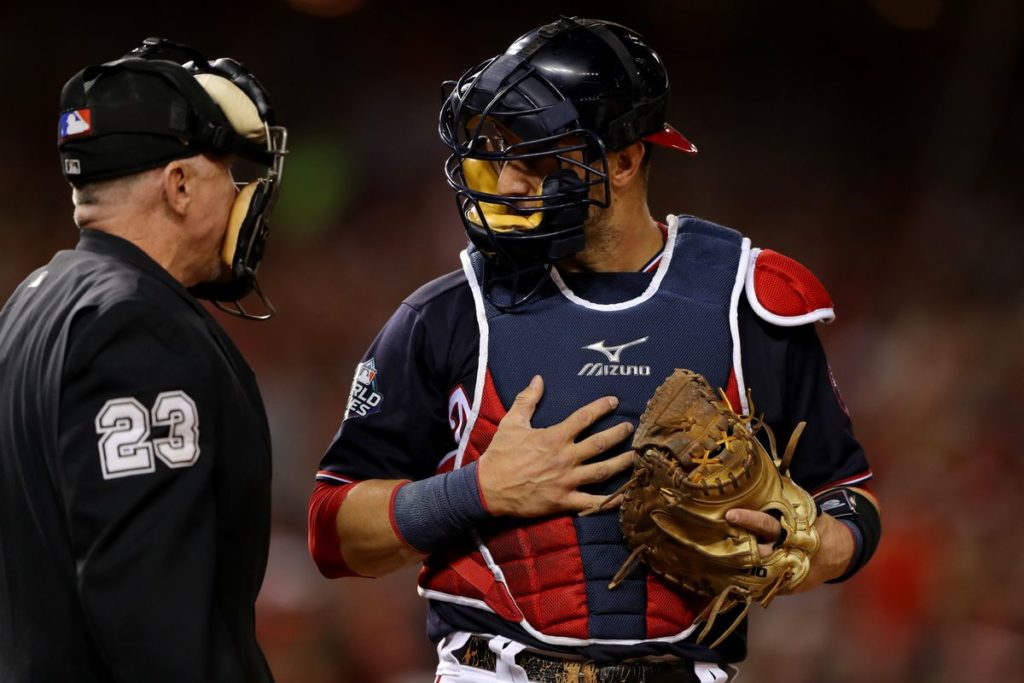Digitized strike zones can reduce umpire blunders

By DERON SNYDER (as published in The Washington Times)
Mathematical psychologist Anatol Rapoport, a founder of general systems theory, once used an amusing baseball anecdote to illustrate knowledge certainty.
One umpire said, “Some is strikes and some is balls, and I calls them as they is.” Another umpire said, “Some is strikes and some is balls, and I calls them as I sees them. The third umpire, whom Rapoport labeled the wisest, said “Some is strikes and some is balls, but they ain’t nothing till I calls them.”
The latter ump is hilarious and I’d love to hear his stand-up routine. Technically, he’s absolutely correct: Pitches are nothing until he says so.
But folks make their own ruling before he opens his mouth. And his pronouncement never changes opposing points of view, especially when replays confirm his erroneous verdicts.
Presented with pitch graphs from Game 5 of the World Series, I’m sure home plate umpire Lance Barksdale would admit what millions of us already know – he blew several ball-strike calls that played a role in Houston’s 7-1 victory against Washington. While no performance behind the plate is likely to top Eric Gregg’s legendary malpractice in Game 5 of the 1997 National League Championship Series, Barksdale merits Dishonorable Mention based on the severity and the stakes.
Unlike Gregg – whose Dade County-sized zone seemed to favor Florida’s Livan Hernandez (15 strikeouts) compared to Atlanta’s Greg Maddux (nine) – Barksdale was an equal-opportunity offender Sunday.
Houston shortstop Carlos Correa homered in the top of the fourth inning, one pitch after taking what appeared to be strike three from Joe Ross. There were multiple baffling calls against both teams in the sixth inning. The Astros were furious in the top of the seventh, and the Nationals were livid in the bottom, when Victor Robles was called out on ball four.
“I will never sit here and criticize an umpire,” Washington manager Dave Martinez said afterward.
“There’s so much emotion that goes on in these plays,” Houston manager AJ Hinch said of both dugouts erupting over seventh-inning calls. “Depending on which side you are on, you’re going to have that reaction.”
Unless you’re simply on the “get-it-right” side.
Consistency is all anyone can ask for. Regardless of the pitcher’s resume or the batter’s prowess, and irrespective of the umpire’s previous call or his activities the night before, a steady strike zone is as good as it gets. As long as the same pitches are balls/strikes for both teams, there’s no argument.
But humans – including umpires – are too fallible and too imperfect to deliver accurate calls 100 percent of the time.
Umpires don’t receive an “E” for their errors like players do, but mistakes happen all over the field – committed by arbiters behind the plate, at each base, and (in the postseason) down the foul lines. There’s no getting around the human element of any participant.
That being said, we can eliminate (or greatly reduce) blunders made by officials. We can leave outcomes to be decided (almost) solely by the success and failure of players and managers.
I’m not calling for robot umpires.
I’m calling for digitized strike zones, official utilization of something akin to the pitch graphs that MLB provides for every at-bat.
They were all over social media Sunday, illustrating the absurdity of some of Barksdale’s calls.
Let umps stay behind the plate. Let them announce balls and strikes in their own inimitable fashion. Let them incorporate the dramatic flair of Leslie Neilsen’s moonwalking, gyrating, break-dancing umpire in The Naked Gun.
But for goodness sake, don’t let them continue to decide balls and strikes. Technology should do that.
Just relay the split-second call to umpires, via earpiece, and let them relay it to everyone else.
Technology doesn’t offer makeup calls, subconsciously or otherwise. Technology isn’t offended when players make presumptions and wrongly head toward first base or the dugout. Technology isn’t influenced or intimidated, or subject to choke under pressure on the biggest stage.
Is it perfect? No. Testing in the Arizona Fall League proves that a prospective system has a long way to go. But that’s the direction baseball should take, full speed ahead.
At least pitch graphs provide a consistent, objective standard, opposed to whatever we get from various umpires on given nights throughout the course of a game.
“Lance did not lose us the game tonight,” Washington first baseman Ryan Zimmerman said.
True.
But Barksdale’s arbitrary calls definitely played a role and became a major talking point in Game 5’s aftermath. A digitized system would eliminate most of the controversy and much of the chatter while increasing accuracy and fairness.
Until then, Barksdale and MLB plate umpires everywhere represent a human element that’s unnecessary, unbecoming and unwelcome.
Even non-scholars can make that call.
— Brooklyn-born and Howard-educated, Deron Snyder writes his award-winning column for The Washington Times on Tuesdays and Thursdays. Follow him on Twitter @DeronSnyder.
 Follow
Follow
